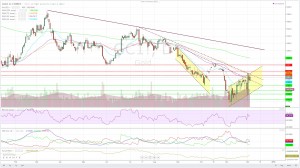Gold has found comfort in weaker than expected economic data and over-bearishness.
 Bullion.Directory precious metals analysis 3 December, 2014
Bullion.Directory precious metals analysis 3 December, 2014
By Christopher Lemieux
Senior FX and Commodities Analyst at FX Analytics
Traders were quite surprised to see gold rebound to $1,219 per toz. on Monday, after the precious metal was pushed to $1,140 on headlines that 77 percent of the Swiss voters voted against the SNB to purchase nearly 1,500 tons over the course of five years. Analysts can continue to be overly bearish on gold, but the fact that gold is now positive on the year is an indication that there is still demand, even in the paper markets.
Today, gold received bids on a weaker than forecasted ADP job reports. According to ADP, only 208,000 jobs were added in November, opposed to the 223,000 expected by economists. This was a drop of 25,000 jobs from the previous month’s upward revised figure. This was the first drop since 2008 and the worst November jobs gain since 2010. Market participants are getting mixed signals, too. The US manufacturing and non-manufacturing PMI data has been quite different than the Institute of Supply Management (ISM) PMI data. Both US PMI figures have ticked lower to multi-month lows, while the ISM PMI data suggested a more positive tone. Markit, provider of the US data sets, tell a stark story that if nothing changes that growth will slow down. This week, we also had Citi’s Macro Surprise Index hit 2008-lows, suggesting 2014 has not shaped up like analysts’ predicted. A lot of indications are showing that 2014 is looking a lot like 2008. What may follow could be ugly.
Gold have flirted above $1,200, but it has been difficult to get continuous closes above this key psychological level. Technically, price action has challenged a descending trend line created in July, which has held as resistance near $1,212 per toz. A close above this resistance level would help aid the yellow metal’s advancement to upside potential of $1,224 and $1,240. Failure to do so, gold will likely trend lower to a demand zone located between $1,196 and $1,200. Further support can be located at $1,184 and $1,171. The 20-day EMA is beginning to slop upwards, which is an encouraging sign. The ability to cross above the 50-day EMA will prove even more bullish.
The US dollar index is higher on the day, just a tad below 89. The move in the dollar is capping the gains in gold. However, if history repeats itself, the roles of gold and the dollar will reverse drastically. The Federal Reserve has been tight lipped recently, but a stronger dollar will continue to pressure inflation expectations. In reaction, the Federal Reserve will intervene to some degree. In recent years, the dollar has reached 90 three other times since 2009. Shortly thereafter, the dollar sank below 76 each time.












 Material provided on the Bullion.Directory website is strictly for informational purposes only. The content is developed from sources believed to be providing accurate information. No information on this website is intended as investment, tax or legal advice and must not be relied upon as such. Please consult legal or tax professionals for specific information regarding your individual situation. Precious metals carry risk and investors requiring advice should always consult a properly qualified advisor. Bullion.Directory, it's staff or affiliates do not accept any liability for loss, damages, or loss of profit resulting from readers investment decisions.
Material provided on the Bullion.Directory website is strictly for informational purposes only. The content is developed from sources believed to be providing accurate information. No information on this website is intended as investment, tax or legal advice and must not be relied upon as such. Please consult legal or tax professionals for specific information regarding your individual situation. Precious metals carry risk and investors requiring advice should always consult a properly qualified advisor. Bullion.Directory, it's staff or affiliates do not accept any liability for loss, damages, or loss of profit resulting from readers investment decisions.

Leave a Reply